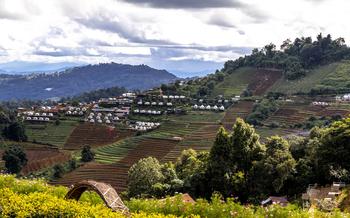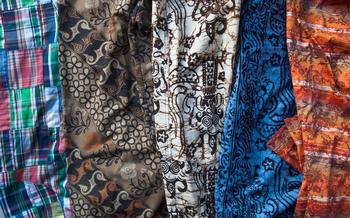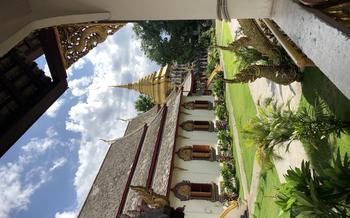
Bo Sang Handicraft Village
- Bo Sang Handicraft Village: A Haven for Artisans
- Umbrellas Galore: The Village's Signature Craft
- Colorful Lanterns: Illuminating the Night Sky
- Cotton and Silk Weavings: Threads of Tradition
- Bamboo Crafts: Nature's Canvas
- Ceramics and Pottery: Earthen Masterpieces
- Wood Carvings: Intricate Expressions
- Silversmithing: Adorning Elegance
- Leather Crafts: Durable Delights
- Papier-Mâché Crafts: Whimsical Creations
- Visiting Bo Sang: A Cultural Experience
- Shopping Tips: Ensuring Authenticity
- Exploring Local Delicacies: Culinary Delights
- Insider Tip: Off-the-Beaten-Path Gems
Bo Sang Handicraft Village: A Haven for Artisans
Nestled amidst the serene landscapes of Chiang Mai, Thailand, lies the enchanting Bo Sang Handicraft Village, a haven for skilled artisans and a treasure trove of exquisite handmade crafts. With a rich history dating back centuries, the village has become renowned for its vibrant umbrellas, intricate lanterns, and diverse array of traditional handicrafts that reflect the cultural heritage of Northern Thailand.
Bo Sang's artisans have inherited their exceptional skills from generations of ancestors, passing down techniques and designs that have stood the test of time. The village is a testament to the dedication and passion of these artisans, who pour their hearts and souls into creating unique and beautiful pieces that showcase their mastery.
Getting to Bo Sang is a breeze, with convenient transportation options available from Chiang Mai. The village is situated just a short distance from the city center, making it an ideal destination for a day trip or a longer exploration.
As you step into Bo Sang Handicraft Village, you'll be greeted by a kaleidoscope of colors and a symphony of sounds. The air is filled with the rhythmic tapping of hammers, the gentle hum of spinning wheels, and the cheerful chatter of artisans sharing stories and laughter.
Supporting local artisans and preserving traditional crafts is of utmost importance to ensure the continuation of this rich cultural heritage. By purchasing directly from the artisans, you not only contribute to their livelihood but also play a vital role in preserving the unique traditions and skills that make Bo Sang so special.
Umbrellas Galore: The Village's Signature Craft
In Bo Sang, the art of umbrella making holds a significant place in the village's history and identity. The intricately crafted umbrellas, adorned with vibrant colors and intricate designs, have become synonymous with the village's artisan heritage.
The process of creating these handmade umbrellas is a testament to the skill and patience of the local artisans. It begins with the selection of high-quality bamboo, which is carefully split and shaped into the umbrella's frame. The fabric, often made from cotton or silk, is then meticulously cut and sewn into panels, each showcasing unique patterns and motifs.
Common motifs featured on Bo Sang umbrellas include flowers, animals, and traditional Thai designs, paying homage to the country's rich cultural heritage. The intricate embroidery or painting on the fabric adds depth and vibrancy to these umbrellas, transforming them into works of art.
When selecting an umbrella as a souvenir, it is essential to look for the details that make each piece unique. The quality of the fabric, the intricacy of the embroidery or painting, and the smoothness of the opening and closing mechanism are all factors to consider.
Whether you choose a colorful umbrella to shield yourself from the sun or as a decorative piece to adorn your home, these handcrafted creations from Bo Sang are sure to add a touch of charm and uniqueness to your collection.
Colorful Lanterns: Illuminating the Night Sky
Bo Sang's vibrant handmade lanterns are a testament to the village's rich artistic heritage. Crafted from delicate mulberry paper and bamboo frames, these lanterns come in a myriad of shapes, sizes, and colors, each one a unique work of art.
The process of creating these lanterns is both intricate and captivating. Artisans carefully select the finest mulberry paper, which is then soaked in a natural dye bath to achieve the desired color. Once the paper has dried, it is stretched over a bamboo frame and meticulously cut into intricate patterns. The resulting design allows light to filter through, creating a mesmerizing display when the lantern is illuminated.
Lanterns in Bo Sang often feature traditional Thai motifs and symbols, such as elephants, flowers, and mythical creatures. These motifs hold deep cultural significance, representing good luck, prosperity, and happiness. During festivals and celebrations, the streets of Bo Sang are adorned with hundreds of these colorful lanterns, creating a magical and enchanting atmosphere.
When choosing a lantern as a souvenir, it is important to consider its size, design, and quality. Look for lanterns with intricate patterns and vibrant colors that appeal to your personal taste. To ensure durability, check the sturdiness of the bamboo frame and the quality of the paper.
Transporting a lantern safely requires careful handling. Wrap the lantern in tissue paper or bubble wrap to protect it from damage during travel. Avoid placing heavy objects on top of the lantern, as this could crush or deform it. With proper care, your Bo Sang lantern will serve as a beautiful reminder of your travels and bring a touch of Thai charm to your home.
Cotton and Silk Weavings: Threads of Tradition
Bo Sang's rich weaving history is deeply intertwined with the cultural identity of the village. The skilled artisans here have mastered the art of transforming cotton and silk fibers into exquisite woven masterpieces. Using traditional handlooms, they meticulously create intricate patterns and designs that reflect the essence of Northern Thai culture.
The weaving process begins with selecting high-quality cotton or silk threads, which are then dyed using natural or synthetic dyes to achieve vibrant hues. The threads are skillfully arranged on the loom, and the weaver uses a combination of foot pedals and hand movements to manipulate the warp and weft threads, creating the intricate patterns that characterize Bo Sang's textiles.
Visitors to the village can observe the weavers at work, marveling at their dexterity and precision. The woven fabrics are then transformed into a variety of products, including clothing, bags, scarves, and home décor items. Each piece is unique, showcasing the creativity and craftsmanship of the artisans.
When shopping for cotton and silk products in Bo Sang, it's important to look for high-quality materials and intricate weaving techniques. Supporting local artisans by purchasing their products directly helps preserve this traditional craft and ensures that the skills are passed down to future generations.
Bamboo Crafts: Nature's Canvas
Bo Sang artisans have mastered the art of transforming humble bamboo into exquisite handicrafts. Bamboo's versatility allows for a range of products, from intricate baskets to sturdy furniture and decorative items.
The process begins with selecting the right bamboo poles, ensuring they are mature and free from defects. Artisans then split the bamboo into thin strips, which are meticulously woven, bent, and shaped into various forms.
Among the popular bamboo crafts are intricately woven baskets, which come in different sizes and designs, showcasing the artisans' skill and creativity. Bamboo furniture, such as chairs, tables, and shelves, adds a touch of natural elegance to any home.
For those seeking unique decorative pieces, bamboo wind chimes, lamps, and wall hangings are available in abundance. Each item is a testament to the artisans' ability to transform nature's bounty into functional and aesthetic creations.
To ensure durability, artisans often treat the bamboo with natural oils and finishes, enhancing its resistance to wear and tear. By choosing bamboo crafts, you not only support local artisans but also contribute to sustainable practices, as bamboo is a renewable resource.
Ceramics and Pottery: Earthen Masterpieces
In Bo Sang, the art of ceramics and pottery holds a prominent place, reflecting the village's rich cultural heritage and the skill of its artisans. The history of ceramics in Thailand dates back centuries, with influences from various cultures, including Chinese, Khmer, and indigenous traditions.
The process of pottery-making in Bo Sang begins with the selection of high-quality clay, which is then carefully prepared and shaped by hand or using a potter's wheel. The artisans skillfully mold the clay into various forms, from delicate vases and intricate figurines to functional tableware.
After shaping, the pottery pieces undergo a drying process to remove excess moisture. Once dry, they are fired in a kiln at high temperatures, which transforms the clay into durable and long-lasting ceramic ware. The firing process also brings out the vibrant colors and glazes, which are often applied by hand before the final firing.
Bo Sang's potters create a diverse range of ceramic and pottery items, each with its own unique character. Visitors can find tableware, such as plates, bowls, and cups, adorned with intricate patterns and vibrant colors. Decorative vases, often featuring traditional Thai motifs, add a touch of elegance to any home décor. Artistically crafted figurines, depicting mythical creatures, animals, or human forms, showcase the potters' skill in capturing intricate details.
When selecting ceramic or pottery items in Bo Sang, it is essential to look for pieces that are well-crafted and have a smooth, even finish. The glaze should be free of cracks or blemishes, and the colors should be vibrant and consistent. Supporting local potters by purchasing their handcrafted pieces directly contributes to preserving this traditional art form and helps sustain the livelihoods of skilled artisans.
Wood Carvings: Intricate Expressions
Bo Sang's wood carvings are renowned for their intricate designs and meticulous craftsmanship. The village's skilled carvers have inherited a rich tradition of woodworking passed down through generations. The art of wood carving in Bo Sang has deep roots in religious traditions, with many of the intricate carvings adorning temples and shrines throughout the region.
Craftsmen meticulously select high-quality wood, often teak or rosewood, for their carvings. Using hand tools such as chisels, gouges, and mallets, they painstakingly shape and sculpt the wood into intricate forms. The carvings often depict scenes from mythology, nature, or everyday life, showcasing the carvers' exceptional attention to detail.
From delicate figurines to elaborate furniture pieces, each wood carving is a unique work of art. Visitors can find intricately carved wooden sculptures, decorative panels, and furniture, each piece showcasing the skill and artistry of the Bo Sang craftsmen. These carvings not only add beauty and elegance to any space but also carry the spirit of Thai culture and heritage.
Silversmithing: Adorning Elegance
In Bo Sang, the art of silversmithing shines brightly, showcasing the intricate craftsmanship and creativity of local artisans. With a history deeply rooted in the region, silversmithing has become synonymous with the village's rich artistic heritage.
The process begins with the careful selection of high-quality silver, which is then melted and poured into molds to create intricate designs. Skilled silversmiths meticulously shape and refine each piece, using hammers, chisels, and other specialized tools to bring their creations to life.
The resulting silver jewelry and ornaments are a testament to the artisans' exceptional skills and artistry. From delicate necklaces and earrings to intricately crafted silverware, each piece is a masterpiece in its own right, adorned with intricate patterns and motifs that reflect the unique cultural heritage of Bo Sang.
To ensure the authenticity and quality of your silver purchases, it is important to buy directly from the artisans themselves or from reputable shops that support fair trade practices. Look for hallmarks or stamps that indicate the purity of the silver, and don't be afraid to ask the artisans about their techniques and inspiration.
By supporting the silversmiths of Bo Sang, you not only take home a beautiful and unique souvenir but also contribute to the preservation of this traditional craft and the livelihoods of the talented artisans who keep it alive.
Leather Crafts: Durable Delights
Bo Sang's leather crafting tradition is renowned for producing durable and stylish leather goods that are both functional and fashionable. Artisans in the village use high-quality leather, sourced from local tanneries, to create a wide range of products, including bags, wallets, shoes, and belts.
The process of leather crafting begins with the selection of the hide. Artisans carefully inspect each hide to ensure that it is free of blemishes and imperfections. Once the hide has been selected, it is tanned using traditional methods, which involve soaking the hide in a solution of natural tannins. This process helps to preserve the leather and make it more durable.
After tanning, the leather is cut into pieces and sewn together using traditional techniques. Artisans use a variety of stitches to create different patterns and designs. The leather goods are then finished with a protective coating to make them water-resistant and long-lasting.
Bo Sang's leather crafts are known for their intricate designs and high-quality construction. Artisans often incorporate traditional Thai motifs into their work, creating unique pieces that are both stylish and meaningful. Visitors to the village can find a wide variety of leather goods to choose from, making it the perfect place to find a unique souvenir or gift.
When shopping for leather goods in Bo Sang, it is important to look for items that are made from genuine leather. Genuine leather is more durable and will last longer than synthetic materials. It is also important to check the stitching and construction of the item to ensure that it is well-made.
By supporting local leather artisans, visitors to Bo Sang can help to preserve this traditional craft and ensure that it continues to thrive for generations to come.
Papier-Mâché Crafts: Whimsical Creations
In Bo Sang, the art of papier-mâché crafting flourishes, transforming recycled paper and natural materials into whimsical creations. Artisans skillfully mold and shape these humble materials, bringing to life a myriad of forms, from whimsical toys and intricate masks to vibrant decorative items.
The process begins with the preparation of the papier-mâché pulp, a mixture of paper fibers, water, and natural adhesives. This malleable mixture is then applied layer by layer onto molds or free-form structures, creating the desired shapes. Once the desired form is achieved, the papier-mâché is left to dry thoroughly, a process that can take several days.
During the drying process, the artisans carefully smooth and refine the surfaces, ensuring the utmost precision and detail. Once completely dry, the papier-mâché creations are ready for their final transformation. Vibrant paints and intricate designs are applied, bringing these once humble materials to life.
Exploring the papier-mâché section of Bo Sang is like stepping into a world of imagination and whimsy. From playful animal figurines to intricate masks adorned with mythical creatures, each piece is a testament to the artisans' boundless creativity. These charming creations not only make for delightful souvenirs but also serve as a reminder of the village's rich artistic heritage.
Visiting Bo Sang: A Cultural Experience
To fully immerse yourself in the vibrant culture of Bo Sang, plan your visit during one of the many festivals or events held throughout the year. These celebrations showcase traditional Thai music, dance, and performances, allowing you to witness the village's rich heritage firsthand.
When interacting with local artisans, don't hesitate to ask questions about their techniques, inspiration, and the stories behind their creations. They are often eager to share their knowledge and passion for their craft.
Take advantage of your time in Bo Sang to explore nearby attractions that offer a glimpse into the region's history and culture. Visit the ancient temples, such as Wat Phra That Doi Suthep, or delve into the fascinating exhibits at the Chiang Mai National Museum. For a breathtaking natural experience, hike through the scenic Doi Suthep-Pui National Park, home to stunning waterfalls, lush forests, and panoramic views.
Transportation options to Bo Sang include tuk-tuks, songthaews (shared taxis), or renting a bicycle for a leisurely ride through the countryside. Accommodation options range from budget guesthouses to charming boutique hotels, allowing you to customize your stay based on your preferences.
When it comes to dining, indulge in the delicious Northern Thai cuisine offered by local restaurants and markets. Sample the famous khao soi (coconut curry noodle soup), sai ua (Northern-style sausage), and gaeng hang lay (mild pork curry). For vegetarians and vegans, there are plenty of options available, such as tofu curries, stir-fried vegetables, and fresh fruit smoothies.
Shopping Tips: Ensuring Authenticity
When shopping for handicrafts in Bo Sang, it's crucial to support fair trade practices and buy directly from the artisans themselves. This ensures that the craftspeople receive a fair wage for their work and that the profits stay within the local community. Look for stalls or workshops where artisans are actively creating their products, and engage in conversation with them to learn about their techniques and inspiration.
To identify genuine handicrafts, pay attention to the quality of the materials and construction. Handmade items often have slight variations in color, size, or design, which is a sign of their uniqueness. Avoid items that look mass-produced or have a plastic-like feel.
Bargaining is a common practice in Thailand, but it's important to do so politely and respectfully. Start by offering a fair price, and be willing to compromise to reach a mutually agreeable price. Remember, the goal is to support the artisans while also getting a good deal for yourself.
Before leaving Thailand, check the export regulations for any restrictions on taking handicrafts out of the country. Some items, such as antiques or endangered species products, may require special permits. It's also a good idea to pack your handicrafts carefully to avoid damage during your travels.
Exploring Local Delicacies: Culinary Delights
A visit to Bo Sang is not complete without savoring the culinary delights that the region has to offer. Northern Thai cuisine, with its unique blend of flavors and spices, is a must-try for any food enthusiast.
Start your culinary journey by sampling the famous Khao Soi, a rich and creamy coconut curry noodle soup. Don't miss out on Sai Ua, a grilled Northern sausage infused with herbs and spices. For a refreshing treat, try Khanom Jeen Nam Ngiao, a fermented rice noodle dish served with a tangy tomato-based sauce.
Vegetarian and vegan travelers can rejoice in the abundance of plant-based options available in Bo Sang. Indulge in Khao Soi Pak, a vegetarian version of the classic Khao Soi, or savor Nam Prik Ong, a spicy dip made with roasted peppers and vegetables.
To fully immerse yourself in the local food culture, venture into the night markets that come alive with street food stalls. Here, you'll find an array of grilled meats, fresh salads, and sweet treats that are sure to tantalize your taste buds.
Remember to be adventurous and try new things. Don't be afraid to ask the locals for recommendations or to try dishes that may seem unfamiliar. With its vibrant culinary scene, Bo Sang offers a feast for the senses that will leave you craving for more.
Insider Tip: Off-the-Beaten-Path Gems
For those seeking a deeper dive into the world of Bo Sang's handicrafts, venturing off the beaten path can lead to hidden treasures. Explore the narrow alleys and side streets to discover lesser-known artisans showcasing unique creations. Engage in conversations with them to learn about their techniques and inspirations.
Beyond the village itself, explore nearby communities like San Kamphaeng, famous for its intricate silverwork, or Mae Rim, renowned for its colorful umbrellas and handmade paper. Each village offers its own distinct charm and specialties, providing a glimpse into the diverse range of traditional Thai crafts.
Embrace the opportunity to immerse yourself in the surrounding countryside, visit local farms, and interact with friendly villagers. Take part in workshops or classes to learn firsthand the skills and techniques behind these beautiful handicrafts. Supporting local artisans and communities not only ensures the preservation of these traditional crafts but also creates a meaningful connection with the people and culture of Thailand.







